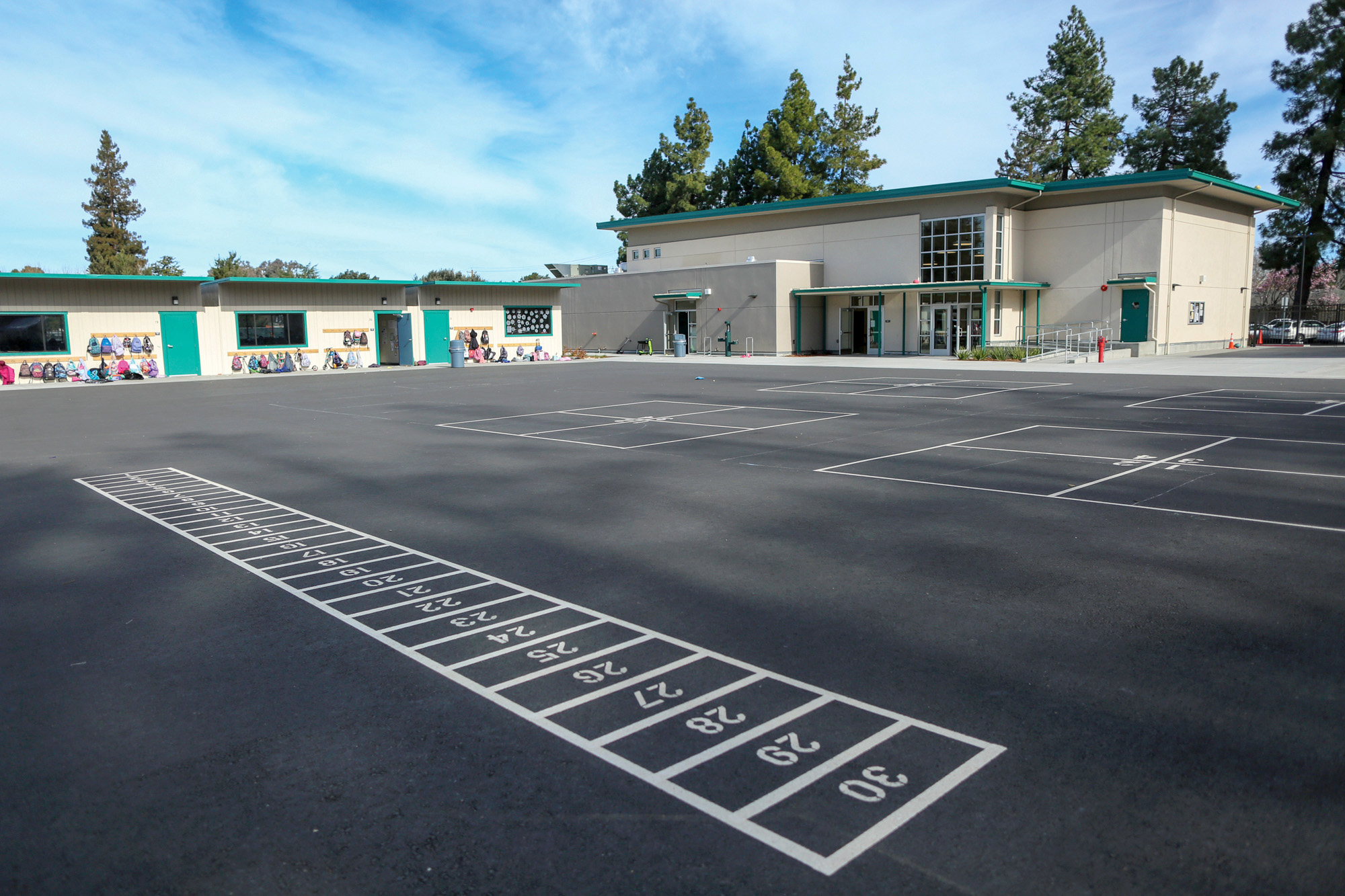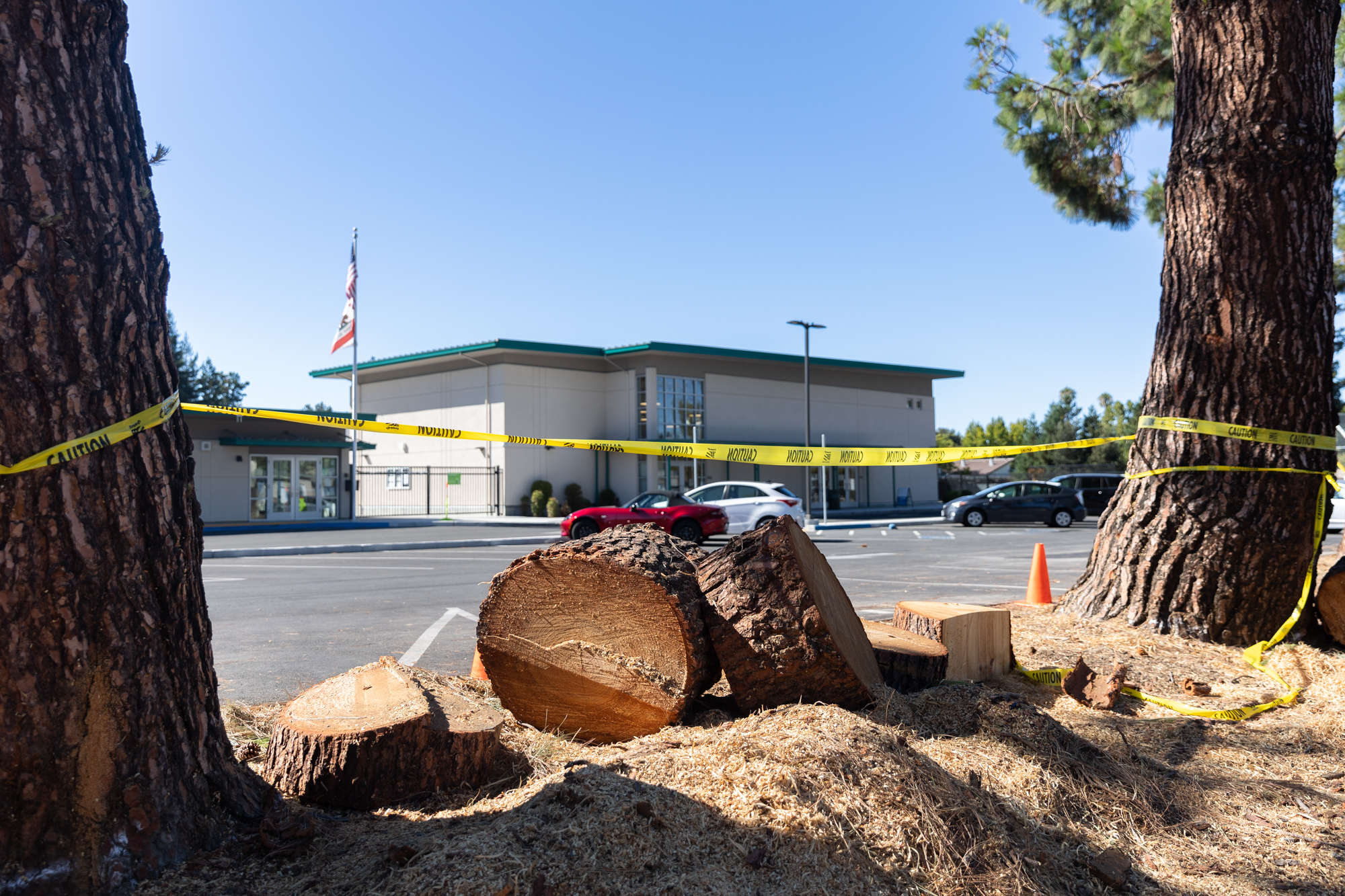When Mountain View Whisman's board decided – over the objections of some community members – to remove nine tall pines in front of Jose Antonio Vargas Elementary School last August, the trustees told district staff to maximize the number of new trees that get planted in their place. Last week, the district unveiled a wide-reaching plan that would involve adding dozens of trees throughout the campus, as well as reimagining the outdoor play areas to incorporate natural elements.
In addition to planting 62 native trees across Vargas' campus, the plan that administrators laid out at a Jan. 12, school board meeting included installing outdoor gathering areas with logs, stumps and stones for seating; adding a native plant and pollinator habitat; and painting the asphalt to reduce the temperature on campus.
District staff said that the project would cost about $600,000, paid for by the Measure T bond that voters approved in 2020, although Chief Business Officer Rebecca Westover stressed that the number is a rough estimate.
The landscape architecture firm Carducci Associates developed the plan for Vargas and presented details about it to the board. Although no formal vote was taken at the meeting, board members were generally supportive of the plans.
"I know that it was really difficult to lose those mature trees at the front of the school," board President Laura Ramirez Berman said. "We made a promise to the community that we would come back and do something that would be so much better for the school community and for the students long term – and I think that … this plan really does that."
The board voted unanimously in August 2022 to remove nine roughly 60-foot-tall Canary Island pines that lined the front of the campus on North Whisman Road because pine cones kept hitting parked cars. The original plan was to build a protective structure above the parking area, but the $635,899 construction contract was too pricey for the board to stomach.
Some local residents objected to the decision to chop down the mature pines, with GreenSpacesMV sending the district a letter of objection signed by 21 people.
At the Jan. 12 meeting, only two people addressed the board about the plans for Vargas: the school's principal, who praised the plans, and a member of the public, who wanted the new trees to have protective barriers around them to prevent children from potentially injuring themselves or the trees.
A broader campus redesign
Opening in 2019, Vargas is the district's newest campus and also its smallest, sitting on just 4.7 acres. That compact footprint, much of which is covered by concrete, has made adding more trees difficult. An emergency vehicle access lane cuts through the center of the campus, there's a solar array that can't be obstructed and there is already a large turf field.
"There are quite a few elements to this site that make our opportunities here limited," George Loew of Carducci told the board.
To redesign the campus, Carducci looked at ways to bring natural elements into the existing outdoor areas and create spaces where teachers can bring their classes, as well as where students can gather informally. Another goal was to use a diverse array of native species that are resilient in the long term and have relatively low maintenance requirements.
"The overarching goal is nature-based, outdoor learning and greening across the site," Loew said.
All areas of the central outdoor portion of the school would be touched by the redesign in some way, said Vince Lattanzio of Carducci. Along the front of the school, where the former trees were removed, Carducci is suggesting primarily planting native oak trees. According to Lattanzio, his company would source trees that are grown in "air bags," which allow them to be 20 feet tall at the time of installation.
One question staff posed to the board was if and how to involve Canopy, a local nonprofit focused on tree planting, stewardship and education. Canopy offered to run a one-hour assembly for students in kindergarten through third grade and a one hour community event for $5,000, with the goal of getting participants excited and more knowledgeable about trees, Westover said.
Board members generally said that they want to move ahead with planting trees as quickly as possible and not slow things down to align the tree planting schedule with Canopy's educational work. Board member Chris Chiang also said that he felt that $5,000 was a steep price tag.
Chiang also said that while he is excited about adding more than 60 trees to the campus, he doesn't have the same level of support for the broader changes to the outdoor space. Given the amount of money involved, he said that he believes there are cheaper ways to give kids outdoor seating.
Another question was whether similar projects should be undertaken at other schools. The district set aside money for outdoor learning spaces during the pandemic, which Superintendent Ayinde Rudolph said could be repurposed for broader "greening" efforts on campus. While Chiang questioned whether there would be sufficient money to cover all the campuses, other board members were more positive about the prospect.
Laura Blakely supported doing these kinds of projects at all campuses, although she said the number of trees that need to be added may vary. Bill Lambert was in favor of moving forward with greening at other campuses, but said that it could be done incrementally over time.
The district plans to hold a meeting about the Vargas proposal for parents and community members on Jan. 24 via Zoom, with the plan coming back for board approval on Feb. 9. To sign up for the community meeting, visit mvw.sd/green124.




Comments
Registered user
Whisman Station
on Jan 16, 2023 at 4:57 pm
Registered user
on Jan 16, 2023 at 4:57 pm
A schedule conflict prevented me from attending the meeting on behalf of GreenSpacesMV, unfortunately, but I'll note here that our organization continues to strongly support greening our local school campus (and other locations, for that matter) and related education programs provided by the District, Canopy, Living Classroom, and others. We firmly believe that a comprehensive education includes hands-on exposure to nature and biodiversity right where the kids study and spend much of their time. We look forward to seeing more information on this as the associated programs develop.
Registered user
Another Mountain View Neighborhood
on Jan 17, 2023 at 5:26 pm
Registered user
on Jan 17, 2023 at 5:26 pm
If a school is being redesigned like this less than four years after opening, it begs the question of why it was designed like this in the first place, with so much "blacktop" and so few native trees.
Registered user
Whisman Station
on Jan 19, 2023 at 12:17 am
Registered user
on Jan 19, 2023 at 12:17 am
Looking forward to bringing back some of the many trees which used to be in that field, before the school cleared 20+ of them. Can't help but notice that the old school next door, now the Google Day Care, has many, large, original trees. And they have children and parked cars, too. Wonder what Google staff know that the City or these contractors do not?
Registered user
North Whisman
on Jan 25, 2023 at 8:46 pm
Registered user
on Jan 25, 2023 at 8:46 pm
Fantastic! Trees! What continues to amaze me is the amount of waste and poor planning that went into this campus. They had to open the school with a diesel generator for months because the school, which was being planned for years, couldn't get the right location to bring power to the school. They then put plastic grass on a lush green ground. They put a sign in the wrong spot (right next to a pole, mind you), which then required them to spend even more money to put up another sign. They then cut down 9 trees with a promise to replace them by fall '22. So much sadness